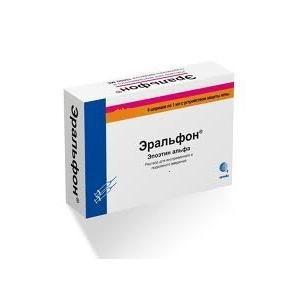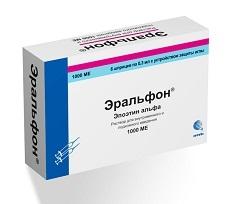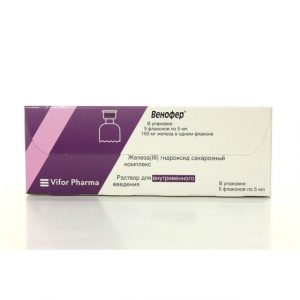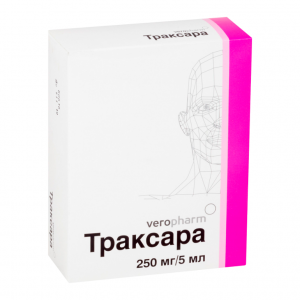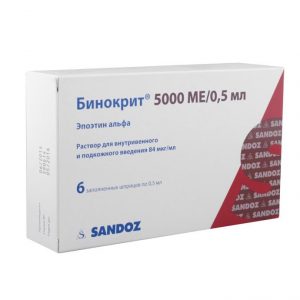Description
Release form
Solution for intravenous and subcutaneous administration in prefilled syringes
Packing
6 syringes.
Pharmacological action
Epoetin alpha – a glycoprotein that specifically stimulates erythropoiesis, activates mitosis and the maturation of red blood cells from erythrocyte progenitor cells. Recombinant epoetin alpha is synthesized in mammalian cells into which a gene encoding human erythropoietin is inserted. In its composition, biological and immunological properties, epoetin alpha is identical to natural human erythropoietin. The administration of epoetin alpha leads to an increase in hemoglobin and hematocrit levels, improving blood supply to tissues and heart function. The most pronounced effect of the use of epoetin alfa is observed in anemia caused by chronic renal failure. In very rare cases, with prolonged use of erythropoietin for the treatment of anemic conditions, the formation of neutralizing antibodies to erythropoietin with or without partial red cell aplasia may be observed.
Pharmacokinetics
With intravenous administration of epoetin alfa in healthy individuals and patients with T1 / 2 uremia – 5-6 hours. With subcutaneous administration of epoetin alpha, its concentration in the blood increases slowly and reaches a maximum in the period from 12 to 18 hours after administration, T1 / 2 – 16-24 hours. The bioavailability of epoetin alfa with subcutaneous administration is 25 40%. Does not cumulate.
Indications
anemia in patients with chronic renal failure, including hemodialysis
prophylaxis and treatment of anemia in patients with solid tumors whose anemia is a consequence of antitumor therapy
prophylaxis and treatment of anemia in patients infected with human immunodeficiency virus (HIV) caused by the use of zidovudine, at an endogenous erythropoietin level of less than 500 IU / ml
, the prevention and treatment of anemia in patients with myeloma, non-Hodgkin s lymphomas of low malignancy, chronic lymphocytic leukemia, rheumatoid arthritis
treatment and prevention of anemia in premature babies born with low body weight (up to 1.5 kg)
as part of the pre-deposit program before extensive surgery in patients with a hematocrit level of 33 39%, to facilitate the collection of autologous blood and reduce the risk associated with the use of llogennyh transfusions if the anticipated need for transfused blood exceeds the number that can be obtained by collecting autologous without epoetin alfa
prior to major surgery with the expected blood loss 900-1800 ml in adults, without anemia or with mild to moderate anemia (hemoglobin level 100 130 g / l), to reduce the need for allogeneic blood transfusions and to facilitate the restoration of erythropoiesis.
Contraindications
hypersensitivity to the drug Eralfon or its components
partial red cell aplasia after previous treatment with any erythropoietin
uncontrolled arterial hypertension
inability to conduct adequate anticoagulant ocular disease and severe coronary artery disease including acute and recent myocardial infarction and acute cerebrovascular accident (as part of deposit program of blood collection prior to surgery).
Precautions: malignant neoplasms epileptic syndrome, incl. history of thrombocytosis, thrombosis (history) sickle cell anemia, iron, B12- or folio-deficient conditions of porphyria chronic liver failure.
Use during pregnancy and lactation
Due to the fact that there is insufficient experience with the use of erythropoietin in pregnancy and lactation in humans, epoetin alfa should be prescribed only if the expected benefits from its use outweigh the possible risk to the fetus and mother. It is not known whether epoetin alfa is excreted in breast milk.
Special instructions
During treatment, it is necessary to monitor blood pressure weekly and conduct a general blood test (including platelets, hematocrit, ferritin). In the pre- and postoperative period, hemoglobin levels should be monitored more often if the initial level was
. Patients with a history of controlled arterial hypertension or thrombotic complications may need to increase the dose of antihypertensive drugs and / or anticoagulants, respectively. When prescribed to patients with liver failure, it is possible to slow down the metabolism of epoetin alpha and a marked increase in erythropoiesis. The safety of the drug in this category of patients has not been established. Although the drug stimulates erythropoiesis, the possibility of the effects of epoetin alpha on the growth of certain types of tumors cannot be completely excluded. bone marrow.
The possibility of a preoperative increase in hemoglobin levels may be a predisposing factor for the development of thrombotic complications. Before a planned surgical intervention, patients should receive adequate preventive antiplatelet therapy. In the pre- and postoperative period, the drug is not recommended for patients with an initial hemoglobin level of more than 150 g / l.
In adult patients with chronic renal failure, clinically severe coronary artery disease, or chronic heart failure, the hemoglobin level should not exceed 100-120 g / l.
Before starting treatment, possible causes of an inadequate reaction to the drug (deficiency of iron, folic acid, cyanocobalamin, severe poisoning with aluminum salts, concomitant infections, should be excluded inflammatory processes and injuries, hidden bleeding, hemolysis, bone marrow fibrosis of various etiologies) and, if necessary, adjust treatment.
Before starting treatment, iron stores in the body should be evaluated. In most patients with chronic renal failure, cancer and HIV-infected patients, the concentration of plasma ferritin decreases simultaneously with an increase in the level of hematocrit. The concentration of ferritin must be determined during the entire course of treatment. If it is less than 100 ng / ml, iron replacement therapy is recommended for oral administration at a rate of 200-300 mg / day (100-200 mg / day for children). Premature infants should be given oral iron therapy at a dose of 2 mg / day as soon as possible. Patients, donating autologous blood and in the pre- or postoperative period should also receive an adequate amount of iron inside at a dose of 200 mg / day.
In patients with chronic renal failure, correction of anemia can cause improved appetite and increased absorption of potassium and protein. Periodic dialysis correction may be required to maintain urea, creatinine, and potassium concentrations within normal limits.
In patients with chronic renal failure, serum electrolytes should be monitored.
According to reports, the use of epoetin alfa in predialysis patients does not accelerate the progression of chronic renal failure. Due to the increase in hematocrit, it is often required to increase the dose of heparin during hemodialysis. With inadequate heparinization, dialysis system blockage, vascular access thrombosis are possible, especially in patients with a tendency to hypotension or complications of arteriovenous fistula (including stenosis, aneurysm). In such patients, the prevention of thrombosis is recommended.
When used in women of reproductive age with anemia in the presence of chronic renal failure, menstruation may resume. The patient should be warned about the possibility of pregnancy and the need to use reliable methods of contraception before starting therapy. In experimental studies in rats and rabbits, no teratogenic effect was observed with iv administration at doses up to 500 U / kg / day at higher doses, a slight, statistically insignificant decrease in fertility was observed.
Given the possible more pronounced effect of the drug, its dose should not exceed the dose of recombinant erythropoietin used in the previous course of treatment. During the first 2 weeks, the dose is not changed, the dose / response ratio is estimated. After this, the dose can be reduced or increased (see “Method of administration and dose”).
Influence on the ability to drive vehicles and work with mechanisms. During the treatment period, before establishing the optimal maintenance dose, patients with chronic renal failure should be careful when driving vehicles and engaging in other potentially dangerous activities that require an increased concentration of attention and speed of psychomotor reactions (increased risk of increased blood pressure at the beginning of therapy).
Composition
1 syringe (0.3 ml) contains: active substance: epoetin alpha (REPOETIN-SP – recombinant human erythropoietin) 3000 IU,
excipients: albumin solution in terms of dry albumin – 1 mg of sodium citrate pentasesquihydrate – 2.32 mg or sodium citrate dihydrate – 1.9104 mg sodium chloride – 2.336 mg of citric acid monohydrate – 0.0228 mg water for injection – up to 0.4 ml.
Dosage and administration of
Treatment of anemia in patients with chronic renal failure
Adults on hemodialysis. Eralfon is administered subcutaneously or intravenously at the end of the dialysis session. When changing the method of administration, the drug is administered in the same dose, then adjust the dose if necessary (with a subcutaneous route of administration of the drug, to achieve the same therapeutic effect, a dose of 20-30% is required than with intravenous administration). Treatment with the drug includes two stages.
1. Correction stage: with subcutaneous administration of the drug, the initial single dose is 30 IU / kg 3 times a week. With intravenous administration of the drug, the initial single dose is 50 IU / kg 3 times a week. The correction period lasts until the optimal hemoglobin level (100 120 g / l in adults and 95 110 g / l in children) and hematocrit (30 35%) are reached. These indicators must be monitored weekly.
The following situations are possible:
– the hematocrit rises from 0.5 to 1% per week. In this case, the dose is not changed until optimal
values are achieved – the hematocrit growth rate is less than 0.5% per week.One-time increase in a single dose is 1.5 times
– the growth rate is more than 1% per week. In this case, it is necessary to reduce the single dose of the drug by 1.5 times
– the hematocrit remains low or decreases. It is necessary to analyze the causes of resistance before increasing the dose of the drug.
The effectiveness of therapy depends on a properly selected individual treatment regimen.
2. Stage of maintenance therapy: to maintain hematocrit at the level of 30 35%, the dose of the drug used at the stage of correction should be reduced by 1.5 times. Then, the maintenance dose of the drug is selected individually, taking into account the dynamics of hematocrit and hemoglobin levels.
Children on hemodialysis. The initial dose is 50 U / kg 3 times a week. If necessary, a single dose is increased 1 time in 4 weeks by 25 IU / kg to achieve the optimal hemoglobin concentration. The maintenance dose in children weighing less than 10 kg is 75 150 PIECES / kg (on average 100 PIECES / kg) 3 times a week 10-30 kg – 60 150 PIECES / kg (on average 75 PIECES / kg) 3 times per week more than 30 kg – 30 100 U / kg (average 33 U / kg) 3 times a week.
Adult predialysis patients. The initial dose is administered subcutaneously or intravenously 3 times at 50 units / kg per week. If necessary, a single dose is increased 1 time in 4 weeks by 25 units / kg until the optimal hemoglobin concentration is achieved. The maintenance dose is 17 33 units / kg 3 times a week.
Prevention and treatment of anemia in patients with solid tumors
Before starting treatment, it is recommended to determine the level of endogenous erythropoietin. When the concentration of serum erythropoietin is less than 200 IU / ml, the initial dose of the drug is 150 IU / kg 3 times a week with the intravenous route of administration. If after 4 weeks of treatment the hemoglobin level rises and is at least 10 g / l or the number of reticulocytes has increased by more than 40,000 cells / μl above the initial level, the dose of the drug remains the same (150 IU / kg 3 times a week).
If, after 4 weeks of treatment, the increase in hemoglobin level is less than 10 g / l and the increase in the number of reticulocytes is less than 40,000 cells / μl compared to the initial level, then over the next 4 weeks the dose is increased to 300 IU / kg 3 times a week. If after an additional 4 weeks of treatment at a dose of 300 IU / kg, the hemoglobin level has increased and is at least 10 g / l or the number of reticulocytes increases by more than 40,000 cells / μl, then the existing dose of the drug (300 IU / kg 3 times a week is maintained ) If after 4 weeks of treatment at a dose of 300 IU / kg, the hemoglobin level has increased by less than 10 g / l and the increase in the number of reticulocytes is less than 40,000 cells / μl compared to the initial level, treatment should be discontinued. If the hemoglobin level increases by more than 20 g / l during the month, the dose should be reduced by 25%. If the hemoglobin level exceeds 140 g / l, it is necessary to suspend treatment until the hemoglobin level drops below 120 g / l and then continue to administer the drug at a dose 25% lower than the original.
Therapy with the drug should continue for 1 month after the end of the course of chemotherapy.
Serum ferritin level (or serum iron level) must be determined in all patients before and during treatment with the drug. If necessary, an additional intake of iron is prescribed.
Prevention and treatment of anemia in patients with HIV infection
It is recommended to determine the initial level of endogenous erythropoietin in the blood serum before starting treatment with Eralfon. Studies have shown that with an erythropoietin level of more than 500 IU / ml, the effect of drug therapy is unlikely.
Treatment with the drug includes 2 stages.
1. Correction stage: the drug is prescribed at a dose of 100 IU / kg 3 times a week subcutaneously or intravenously for 8 weeks. If after 8 weeks of therapy it was not possible to achieve a satisfactory effect (for example, to reduce the need for blood transfusions or to increase the level of hemoglobin), the dose can gradually increase (not more than 1 time in 4 weeks) by 50-100 IU / kg 3 times a week. If it was not possible to achieve a satisfactory effect of therapy with the drug Eralfon at a dose of 300 IU / kg 3 times a week, then a response to further therapy at higher doses is unlikely.
2. Stage of maintenance therapy: after achieving a satisfactory effect in the phase of correction of anemia, the maintenance dose should provide a hematocrit level of 30 35% depending on changes in the dose of zidovudine, the presence of concomitant infectious or inflammatory diseases. With a hematocrit of more than 40%, administration of the drug should be stopped until the hematocrit decreases to 36%. When resuming therapy, the dose of epoetin alpha should be reduced by 25%, followed by adjustment to maintain the required level of hematocrit. Serum ferritin level (or serum iron level) must be determined in all patients before and during treatment with the drug. If necessary, an additional intake of iron is prescribed.
Prevention and treatment of anemia in patients with myeloma, non-Hodgkin’s lymphomas of low malignancy and chronic lymphocytic leukemia
In these patients, the feasibility of treatment with epoetin alfa is due to inadequate synthesis of endogenous erythropoietin against the background of the development of anemia. At a hemoglobin level below 100 g / l and serum erythropoietin below 100 IU / ml, Eralfon is administered subcutaneously at a starting dose of 100 IU / kg 3 times a week. Laboratory monitoring of hemodynamic parameters is carried out weekly. If necessary, the dose is adjusted in the direction of increase or decrease every 3-4 weeks. If, upon reaching a weekly dose of 600 IU / kg, an increase in hemoglobin level is not observed, further use of epoetin alpha should be discontinued as ineffective.
Prevention and treatment of anemia in patients with rheumatoid arthritis
In patients with rheumatoid arthritis, suppression of the synthesis of endogenous erythropoietin is observed under the influence of an increased concentration of pro-inflammatory cytokines. Treatment of anemia in these patients is carried out with the drug with subcutaneous administration at a dose of 50 75 IU / kg 3 times a week. With an increase in hemoglobin level of less than 10 g / l after 4 weeks of treatment, the dose of the drug is increased to 150-200 IU / kg 3 times a week. A further increase in dose seems inappropriate.
Treatment and prevention of anemia in premature babies born with low body weight
Eralfon is administered subcutaneously at a dose of 200 IU / kg 3 times a week, starting from the 6th day of life until the target levels of hemoglobin and hematocrit are reached, but not more than 6 weeks .
Adult patients participating in an autologous blood collection program before
surgery. It is recommended that you use the intravenous route of administration. Epoetin alfa should be administered at the end of the blood collection procedure.
Before prescribing the drug, all contraindications to the collection of autologous blood should be considered. Before surgery, Eralfon should be prescribed 2 times a week for 3 weeks. At each visit to the doctor, a portion of blood is taken from the patient (if hematocrit? 33% and / or hemoglobin level? 110 g / l) and stored for autologous transfusion. The recommended dose of Eralfon is 600 IU / kg iv twice a week.
Serum ferritin level (or serum iron level) must be determined in all patients before and during treatment with the drug. If necessary, an additional intake of iron is prescribed.
If anemia is present, its cause must be established before starting epoetin alfa therapy. It is necessary to ensure an adequate intake of iron in the body as soon as possible by administering an iron preparation orally at a dose of 200 mg / day (based on ferrous iron), and maintain iron intake at this level throughout the course of therapy.
Patients in the pre- and postoperative period not participating in the autologous blood collection program
It is recommended to use subcutaneous administration of a drug at a dose of 600 IU / kg per week for 3 weeks prior to surgery (21st, 14th and 7th days before surgery), and on the day of surgery. If necessary, when for medical reasons it is necessary to shorten the preoperative period, Eralfon can be prescribed daily at a dose of 300 IU / kg for 10 days before surgery, on the day of surgery and for 4 days after surgery. If the hemoglobin level in the preoperative period reaches 150 g / l and higher, the use of epoetin alpha should be discontinued. Before starting therapy with epoetin alfa, it is necessary to ensure that patients do not have iron deficiency.
All patients should receive an adequate amount of iron (orally 200 mg / day based on ferrous iron) throughout the course of treatment. If possible, an additional oral intake of iron should be provided before the start of epoetin alpha therapy to ensure an adequate iron depot in the patient’s body.
Side effects
At the beginning of treatment, flu-like symptoms may occur: dizziness, drowsiness, fever, headache, myalgia, arthralgia.
From the CCC side: dose-dependent increase in blood pressure, worsening of hypertension (most often in patients with chronic renal failure), in some cases – a hypertensive crisis, a sharp increase in blood pressure with symptoms of encephalopathy (headache, confusion) and generalized tonic-clonic seizures.
From the hemopoietic organs: thrombocytosis, in some cases – shunt or arteriovenous fistula thrombosis (including patients on hemodialysis with a tendency to hypotension or with aneurysm, stenosis), erythrocyte germ aplasia.
Allergic reactions: skin rash (mild or moderate), eczema, urticaria, pruritus, angioedema.
Local reactions: hyperemia, burning, mild or moderate soreness at the injection site (more often with s / c administration).
From the laboratory side: a decrease in the concentration of ferritin in the serum, with uremia – hyperkalemia, hyperphosphatemia.
Other: complications, associated with respiratory failure or with a decrease in blood pressure, immune reactions (induction of antibody formation), exacerbation of porphyria.
Drug interaction
Reduces the concentration of cyclosporine due to an increase in the degree of its binding to red blood cells (it may be necessary to adjust the dose of cyclosporin).
Pharmaceutically incompatible with solutions of other drugs.
Overdose
Symptoms: increased side effects.
Treatment: carry out symptomatic therapy, at high hemoglobin level – bloodletting.
Storage Conditions
At 2 ° to 8 ° C.
Shelf life
2 years.
Active ingredient
Epoetin alfa
Terms and conditions
prescription
Dosage form
solution for injection and infusion
